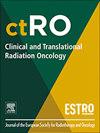机械辅助无创通气治疗肝脏SABR:提高CBCT,治疗更准确
IF 2.7
3区 医学
Q3 ONCOLOGY
引用次数: 0
摘要
背景与目的在肝脏立体定向消融放疗(SABR)过程中,用于图像引导放疗(IGRT)的二束计算机断层扫描(CBCT)会受到呼吸运动伪影的影响,可能危及治疗的准确性。机械辅助无创通气诱导屏气(MANIV-BH)可以减少这些伪影。本研究比较了MANIV-BH和自由呼吸cbct在图像质量、IGRT可变性、自动配准精度和深度学习自动分割性能方面的差异。材料和方法对14例患者进行盲测,其中25例为FB患者,25例为MANIV-BH患者。他们评估了CBCT的质量和IGRT的易用性(与计划CT的严格注册)。比较FB和MANIV-BH之间的操作员间IGRT变异性。使用自动刚性配准和图像引导的可变形配准比较自动总肿瘤体积(GTV)映射精度。操作员对深度学习风险器官(OAR)自动分割进行了评分,并记录了用于手动校正这些体积的时间。结果maniv - bh显著改善了CBCT图像质量(“优”/“好”:83.4%,而FB, p <;0.001),促进IGRT(“非常容易”/“容易”:68.0%,而FB为38.9%,p <;0.001),并降低了IGRT变异性,特别是对于训练有素的操作员(总体变异性为3.2 mm,而FB为4.6 mm, p = 0.010)。MANIV-BH提高了深度学习的自动分割性能(80.0%的评分为“优秀”/“良好”,而FB的评分为4.0%,p <;0.001),与FB相比,中位人工校正时间减少了54.2% (p <;0.001)。MANIV-BH与FB的自动GTV成图精度差异不显著。结论在肝脏SABR中,MANIV-BH可显著提高CBCT质量,降低操作员间IGRT差异,增强OAR自动分割。除了安全有效地缓解呼吸运动外,MANIV还提高了治疗过程中的准确性,尽管其实施需要资源。本文章由计算机程序翻译,如有差异,请以英文原文为准。
Mechanically assisted non-invasive ventilation for liver SABR: Improve CBCT, treat more accurately
Background and purpose
Cone-beam computed tomography (CBCT) for image-guided radiotherapy (IGRT) during liver stereotactic ablative radiotherapy (SABR) is degraded by respiratory motion artefacts, potentially jeopardising treatment accuracy. Mechanically assisted non-invasive ventilation-induced breath-hold (MANIV-BH) can reduce these artefacts. This study compares MANIV-BH and free-breathing CBCTs regarding image quality, IGRT variability, automatic registration accuracy, and deep-learning auto-segmentation performance.
Materials and methods
Liver SABR CBCTs were presented blindly to 14 operators: 25 patients with FB and 25 with MANIV-BH. They rated CBCT quality and IGRT ease (rigid registration with planning CT). Interoperator IGRT variability was compared between FB and MANIV-BH. Automatic gross tumour volume (GTV) mapping accuracy was compared using automatic rigid registration and image-guided deformable registration. Deep-learning organ-at-risk (OAR) auto-segmentation was rated by an operator, who recorded the time dedicated for manual correction of these volumes.
Results
MANIV-BH significantly improved CBCT image quality (“Excellent”/“Good”: 83.4 % versus 25.4 % with FB, p < 0.001), facilitated IGRT (“Very easy”/“Easy”: 68.0 % versus 38.9 % with FB, p < 0.001), and reduced IGRT variability, particularly for trained operators (overall variability of 3.2 mm versus 4.6 mm with FB, p = 0.010). MANIV-BH improved deep-learning auto-segmentation performance (80.0 % rated “Excellent”/“Good” versus 4.0 % with FB, p < 0.001), and reduced median manual correction time by 54.2 % compared to FB (p < 0.001). However, automatic GTV mapping accuracy was not significantly different between MANIV-BH and FB.
Conclusion
In liver SABR, MANIV-BH significantly improves CBCT quality, reduces interoperator IGRT variability, and enhances OAR auto-segmentation. Beyond being safe and effective for respiratory motion mitigation, MANIV increases accuracy during treatment delivery, although its implementation requires resources.
求助全文
通过发布文献求助,成功后即可免费获取论文全文。
去求助
来源期刊

Clinical and Translational Radiation Oncology
Medicine-Radiology, Nuclear Medicine and Imaging
CiteScore
5.30
自引率
3.20%
发文量
114
审稿时长
40 days
 求助内容:
求助内容: 应助结果提醒方式:
应助结果提醒方式:


